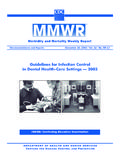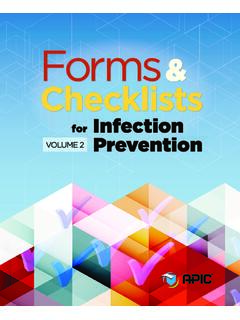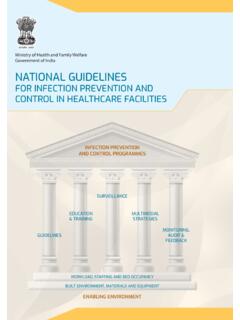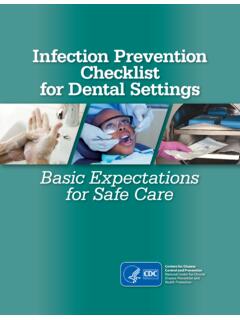Transcription of DEPARTMENT OF HEALTH & HUMAN SERVICES
1 DEPARTMENT OF HEALTH & HUMAN SERVICES Centers for Medicare & Medicaid SERVICES 7500 Security Boulevard, Mail Stop C2-21-16 Baltimore, Maryland 21244-1850 Center for Clinical Standards and Quality/Survey & Certification Group DATE: August 26, 2020 Ref: QSO-20-38-NH REVISED 09/10/2021 TO: State Survey Agency Directors FROM: Director Survey and Certification Group SUBJECT: Interim Final Rule (IFC), CMS-3401-IFC, Additional Policy and Regulatory Revisions in Response to the COVID-19 Public HEALTH Emergency related to Long-Term Care (LTC) Facility Testing Requirements Memorandum Summary CMS is committed to taking critical steps to ensure America s healthcare facilities continue torespond effectively to the Coronavirus Disease 2019 (COVID-19) Public HEALTH Emergency(PHE). On August 25, 2020, CMS published an interim final rule with comment period (IFC). This ruleestablishes Long-Term Care (LTC) Facility Testing Requirements for Staff and , facilities are required to test residents and staff, including individuals providingservices under arrangement and volunteers, for COVID-19 based on parameters set forth by theHHS Secretary.
2 This memorandum provides guidance for facilities to meet the newrequirements. Revised COVID-19 staff testing is based on the facility s county level of communitytransmission instead of county test positivity rate. The frequency of testing has also beenupdated. Facilities now have two options to conduct outbreak testing, through either a contacttracing or broad-based testing August 25, 2020, CMS published an interim final rule with comment period (IFC), CMS-3401-IFC, entitled Medicare and Medicaid Programs, Clinical Laboratory Improvement Amendments of 1988 (CLIA), and Patient Protection and Affordable Care Act; Additional Policy and Regulatory Revisions in Response to the COVID-19 Public HEALTH Emergency . CMS s recommendation below to test with authorized nucleic acid or antigen detection assays is an important addition to other infection prevention and control (IPC) recommendations aimed at preventing COVID-19 from entering nursing homes, detecting cases quickly, and stopping transmission.
3 Swift identification of confirmed COVID-19 cases allows the facility to take immediate action to remove exposure risks to nursing home residents and staff. CMS has added 42 CFR (h) which requires that the facility test all residents and staff for COVID-19. 2 Guidance related to the requirements is located below. Noncompliance related to this new requirement will be cited at new tag F886. Infection control * * * * * (h) COVID-19 Testing. The LTC facility must test residents and facility staff, including individuals providing SERVICES under arrangement and volunteers, for COVID-19. At a minimum, for all residents and facility staff, including individuals providing SERVICES under arrangement and volunteers, the LTC facility must: (1) Conduct testing based on parameters set forth by the Secretary, including but not limited to: (i) Testing frequency; (ii) The identification of any individual specified in this paragraph diagnosed with COVID-19 in the facility; (iii) The identification of any individual specified in this paragraph with symptoms consistent with COVID-19 or with known or suspected exposure to COVID-19; (iv) The criteria for conducting testing of asymptomatic individuals specified in this paragraph, such as the positivity rate of COVID-19 in a county; (v) The response time for test results; and (vi) Other factors specified by the Secretary that help identify and prevent the transmission of COVID-19.
4 (2) Conduct testing in a manner that is consistent with current standards of practice for conducting COVID-19 tests; (3) For each instance of testing: (i) Document that testing was completed and the results of each staff test; and (ii) Document in the resident records that testing was offered, completed (as appropriate to the resident s testing status), and the results of each test. (4) Upon the identification of an individual specified in this paragraph with symptoms consistent with COVID-19, or who tests positive for COVID-19, take actions to prevent the transmission of COVID-19. (5) Have procedures for addressing residents and staff, including individuals providing SERVICES under arrangement and volunteers, who refuse testing or are unable to be tested. (6) When necessary, such as in emergencies due to testing supply shortages, contact state and local HEALTH departments to assist in testing efforts, such as obtaining testing supplies or processing test results. 3 F886 DEFINITIONS Close contact refers to someone who has been within 6 feet of a COVID-19 positive person for a cumulative total of 15 minutes or more over a 24-hour period.
5 Level of community transmission refers to facility s county level of COVID-19 transmission. This metric uses two indicators for categorization (1. Total number of new cases per 100,000 persons within the last 7 days and 2. Percentage of positive diagnostic and screening nucleic acid amplification tests (NAAT) during the last 7 days), which can be found on the Centers for Disease Control and prevention (CDC) COVID-19 Integrated County View site at #county-view. Fully vaccinated refers to the CDC definition. The current definition can be found on CDC s website: Interim Public HEALTH Recommendations for Fully Vaccinated People | CDC. Higher-risk exposure refers to exposure of an individual s eyes, nose, or mouth to material potentially containing SARS-CoV-2, particularly if present in the room for an aerosol-generating procedure. This can occur when staff do not wear adequate personal protective equipment during care or interaction with an individual. For more information, see CDC s "Interim Guidance for Managing Healthcare Personnel with SARS-CoV-2 Infection or Exposure to SARS-CoV-2.
6 " Unvaccinated refers to a person who does not fit the definition of fully vaccinated, including people whose vaccination status is not known, for the purposes of this guidance. GUIDANCE Testing of Nursing Home Staff and Residents To enhance efforts to keep COVID-19 from entering and spreading through nursing homes, facilities are required to test residents and staff based on parameters and a frequency set forth by the HHS Secretary. Facilities can meet the testing requirements through the use of rapid point-of-care (POC) diagnostic testing devices or through an arrangement with an offsite laboratory. POC testing is diagnostic testing that is performed at or near the site of resident care. For a facility to conduct these tests with their own staff and equipment (including POC devices provided by the DEPARTMENT of HEALTH and HUMAN SERVICES ), the facility must have, at a minimum, a CLIA Certificate of Waiver. Information on obtaining a CLIA Certificate of Waiver can be found here.
7 Facilities without the ability to conduct COVID-19 POC testing should have arrangements with a laboratory to conduct tests to meet these requirements. Laboratories that can quickly process large numbers of tests with rapid reporting of results ( , within 48 hours) should be selected to rapidly inform infection prevention initiatives to prevent and limit transmission. Facility staff includes employees, consultants, contractors, volunteers, and caregivers who provide care and SERVICES to residents on behalf of the facility, and students in the facility s nurse 4 aide training programs or from affiliated academic institutions. For the purpose of testing individuals providing SERVICES under arrangement and volunteers, facilities should prioritize those individuals who are regularly in the facility ( , weekly) and have contact with residents or staff. We note that the facility may have a provision under its arrangement with a vendor or volunteer that requires them to be tested from another source ( , their employer or on their own).
8 However, the facility is still required to obtain documentation that the required testing was completed during the timeframe that corresponds to the facility s testing frequency, as described in Table 2 below. When prioritizing individuals to be tested, facilities should prioritize individuals with signs and symptoms of COVID-19 first, then perform testing triggered by an outbreak investigation (as specified below). Table 1: Testing Summary Testing Trigger Staff Residents Symptomatic individual identified Staff, vaccinated and unvaccinated, with signs or symptoms must be tested. Residents, vaccinated and unvaccinated, with signs or symptoms must be tested. Newly identified COVID-19 positive staff or resident in a facility that can identify close contacts Test all staff, vaccinated and unvaccinated, that had a higher-risk exposure with a COVID-19 positive individual. Test all residents, vaccinated and unvaccinated, that had close contact with a COVID-19 positive individual.
9 Newly identified COVID-19 positive staff or resident i n a facility that is unable to identify close contacts Test all staff, vaccinated and unvaccinated, facility-wide or at a group level if staff are assigned to a specific location where the new case occurred ( , unit, floor, or other specific area(s) of the facility). Test all residents, vaccinated and unvaccinated, facility-wide or at a group level ( , unit, floor, or other specific area(s) of the facility). Routine testing According to Table 2 below Not generally recommended Testing of Staff and Residents with COVID-19 Symptoms or Signs Staff with symptoms or signs of COVID-19, vaccinated or not vaccinated, must be tested immediately and are expected to be restricted from the facility pending the results of COVID-19 testing. If COVID-19 is confirmed, staff should follow Centers for Disease Control and prevention (CDC) guidance Interim Guidance for Managing Healthcare Personnel with SARS-CoV-2 Infection or Exposure to SARS-CoV-2.
10 Staff who do not test positive for COVID-19 but have symptoms should follow facility policies to determine when they can return to work. 5 Residents who have signs or symptoms of COVID-19, vaccinated or not vaccinated, must be tested immediately. While test results are pending, residents with signs or symptoms should be placed on transmission-based precautions (TBP) in accordance with CDC guidance. Once test results are obtained, the facility must take the appropriate actions based on the results. NOTE: Concerns related to initiating and/or maintaining TBP should be investigated under F880, Infection Control. Testing of Staff with a Higher-Risk Exposure and Residents who had a Close Contact For information on testing staff with a higher-risk exposure to COVID-19 and residents who had close contact with a COVID-19 positive individual, when the facility is not in an outbreak status, see the CDC s Interim infection prevention and Control Recommendations to Prevent SARS-CoV-2 Spread in Nursing Homes and Interim Guidance for Managing Healthcare Personnel with SARS-CoV-2 Infection or Exposure to SARS-CoV-2.















